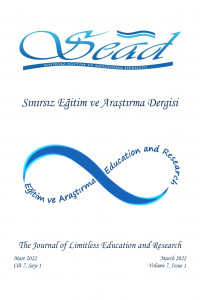Öz
“Sonata”, which has influenced all forms of instrumental music from the Baroque Period to the present, means a multi-part piece composed for one or two instruments. It can be said that from the time of the first sonatas to the current times, almost all composers who are known to have written pieces of instrumental music have produced works in the form of duo sonata. Harboring the musical characteristics of the Classical and Romantic periods, both sonatas written for the cello and piano by Johannes Brahms hold an important place among the works of chamber music. Additionally, upon examination of the cello parts of the sonatas in terms of performance techniques, it can be seen that both sonatas are among the most difficult pieces for performers. This study aimed to examine the right-hand techniques in the cello parts of the two sonatas written for the cello and piano by Johannes Brahms, who was one of the prominent composers of the Romantic Period.
Kaynakça
- Ammer, C. (1992). The Facts On File Music Dictionary, Library of Congress Cataloging in Publication.
- Aybulus, Ş. (2020). Henri Vieuxtemps'in Op.16 Konser Etütleri No.1'de Kullanılan Sağ ve Sol El Teknikleri, Balkan Müzik ve Sanat Dergisi, Cilt 2, Sayı 2.
- Eleanor, H. (2012). Brahms, Rythym and the Renaissance, Humanities and Social Science, Volume 8.
- Geiringer, K. (1961). Brahms His Life and Work (first edition), Anchor Books.
- Henschel, G. (1907). Johannes Brahms "Some of his Letters", The Gorham Press.
- Liberman, M., Berlianchik, M. (2011). Culture of Violin Tone, Moskva-Muzika.
- Sözer, V. (2014). Müzik Terimleri Sözlüğü, Remzi Kitabevi.
Öz
Barok Dönem'den günümüze kadar çalgı müziğinin tüm formlarını etkileyen "sonat", bir ya da iki çalgı için bestelenen çok bölümlü eser anlamına gelmektedir. İlk bestelenen sonatlardan günümüze kadar geçen süre çalgı müziği ağırlıklı eserler yazan hemen her bestecinin düo sonat formunda eserler yazdığı söylenebilir. Johannes Brahms'ın çello ve piyano için yazdığı iki sonat da Klasik ve Romantik dönemlerin müzikal özelliklerini içermeleri nedeniyle oda müziği eserleri içinde önemli bir yere sahiptirler. Ayrıca sonatların çello partileri icra teknikleri açısından incelendiğinde iki sonatın da icracılar için hayli güç eserler arasında yer aldıkları görülmektedir. Bu çalışmada Romantik Dönem'in önde gelen bestecilerinden biri olan Johannes Brahms'ın çello ve piyano için yazdığı iki sonatın çello partilerinde yer alan sağ el tekniklerinin incelenmesi amaçlanmıştır.
Kaynakça
- Ammer, C. (1992). The Facts On File Music Dictionary, Library of Congress Cataloging in Publication.
- Aybulus, Ş. (2020). Henri Vieuxtemps'in Op.16 Konser Etütleri No.1'de Kullanılan Sağ ve Sol El Teknikleri, Balkan Müzik ve Sanat Dergisi, Cilt 2, Sayı 2.
- Eleanor, H. (2012). Brahms, Rythym and the Renaissance, Humanities and Social Science, Volume 8.
- Geiringer, K. (1961). Brahms His Life and Work (first edition), Anchor Books.
- Henschel, G. (1907). Johannes Brahms "Some of his Letters", The Gorham Press.
- Liberman, M., Berlianchik, M. (2011). Culture of Violin Tone, Moskva-Muzika.
- Sözer, V. (2014). Müzik Terimleri Sözlüğü, Remzi Kitabevi.
Ayrıntılar
| Birincil Dil | Türkçe |
|---|---|
| Konular | Eğitim Üzerine Çalışmalar |
| Bölüm | Makaleler |
| Yazarlar | |
| Yayımlanma Tarihi | 15 Mart 2022 |
| Gönderilme Tarihi | 19 Ocak 2022 |
| Kabul Tarihi | 15 Şubat 2022 |
| Yayımlandığı Sayı | Yıl 2022 Cilt: 7 Sayı: 1 |

